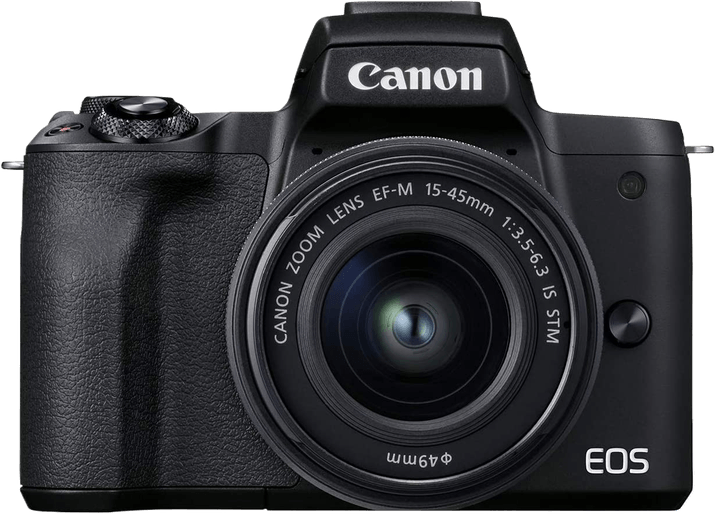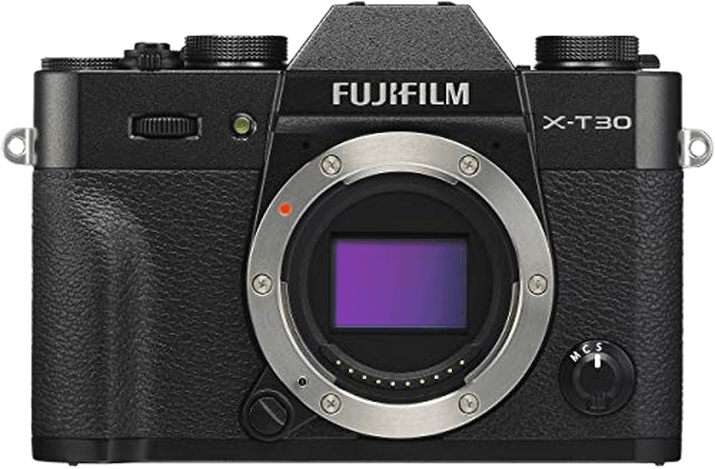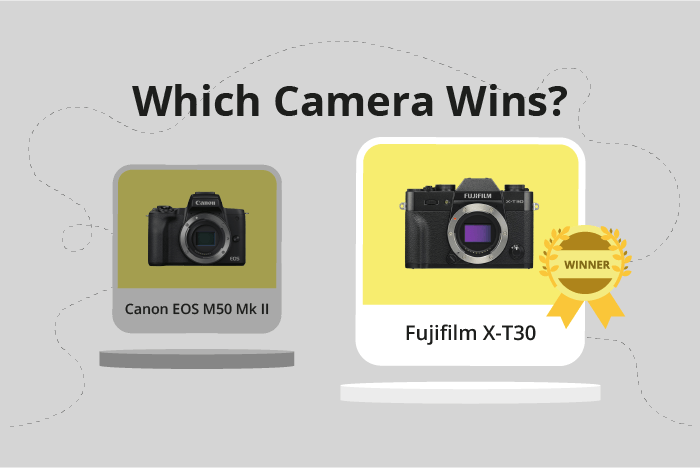Canon EOS M50 Mark II vs Fujifilm X-T30 Comparison
Canon EOS M50 Mark II

Fujifilm X-T30

The Fujifilm X-T30 emerges as the winner with a score of 65/100, while the Canon EOS M50 Mark II trails behind with a score of 59/100. Both cameras are mirrorless and were released in 2019 and 2020, respectively. They share similar sizes and weights, with the Fujifilm X-T30 measuring 118 x 83 x 47mm and weighing 383g, and the Canon EOS M50 Mark II measuring 116 x 88 x 59mm and weighing 387g.
The Fujifilm X-T30’s higher score reveals its superior performance compared to the Canon EOS M50 Mark II. However, the Canon EOS M50 Mark II has a lower launch price of $750, making it a more budget-friendly option compared to the Fujifilm X-T30, which was launched at $899.
Based on these specifications, the Fujifilm X-T30 is a better camera in terms of performance, while the Canon EOS M50 Mark II offers a more affordable choice for photographers who prioritize cost.
Canon EOS M50 Mark II vs Fujifilm X-T30 Overview and Optics
The Fujifilm X-T30 outperforms the Canon EOS M50 Mark II in optics, scoring 67/100 compared to the Canon’s 59/100. Both cameras share some common specifications, including a CMOS sensor, APS-C sensor size, and the lack of image stabilization. However, there are key differences that contribute to the Fujifilm X-T30’s superior performance.
The Fujifilm X-T30 boasts a higher megapixel count at 26, compared to the Canon EOS M50 Mark II’s 24 megapixels. This allows the X-T30 to capture more detail and produce higher resolution images. Additionally, the X-T30 features a significantly faster shooting speed of 30 frames per second (fps), while the Canon only reaches 10 fps. This makes the Fujifilm X-T30 a better choice for capturing fast-moving subjects and action photography.
The Canon EOS M50 Mark II has a DXOMARK score of 58 for its sensor, which is a reputable score. Unfortunately, DXOMARK does not provide scores for Fujifilm cameras, so a direct comparison is not possible. However, the X-T30’s X-Processor 4 is a powerful and efficient processor, which contributes to its overall performance.
Regarding lens mounts, the Canon EOS M50 Mark II uses the Canon EF-M mount, while the Fujifilm X-T30 uses the Fujifilm X mount. Both mounts offer a range of compatible lenses, catering to various photography styles and needs.
Taking all these factors into account, the Fujifilm X-T30 emerges as the superior camera in terms of optics, offering higher resolution images and faster shooting speeds. The Canon EOS M50 Mark II remains a respectable option, but the X-T30’s advantages make it the clear winner in this comparison.
Canon EOS M50 Mark II vs Fujifilm X-T30 Video Performance
The Canon EOS M50 Mark II and the Fujifilm X-T30 both have a video score of 91/100, indicating that their video capabilities are quite similar. Both cameras offer 4K video resolution and a maximum frame rate of 120fps, providing users with high-quality video footage. Additionally, both cameras have built-in time-lapse functionality, making them ideal for capturing stunning time-lapse sequences.
Despite their similarities, the Fujifilm X-T30 has a slight edge in terms of video dimensions, offering 4096 x 2160 pixels compared to the Canon EOS M50 Mark II’s 3840 x 2160 pixels. This means that the X-T30 can capture slightly wider videos, which can be advantageous for certain shooting scenarios, such as landscapes or cityscapes.
On the other hand, the Canon EOS M50 Mark II also has its own benefits. Although it does not have a clear advantage in video specifications, it may offer other features or performance aspects that some users might find more appealing. For example, Canon’s renowned Dual Pixel autofocus system is known for its fast and accurate focusing capabilities, which can be particularly useful for video shooting.
Considering the video capabilities of both cameras, it’s clear that they are quite evenly matched. The Fujifilm X-T30 has a minor advantage in video dimensions, while the Canon EOS M50 Mark II may offer better autofocus performance. Ultimately, the choice between these two cameras will depend on the user’s personal preferences and the specific features they value most in a camera.
Canon EOS M50 Mark II vs Fujifilm X-T30 Features and Benefits
The Canon EOS M50 Mark II and the Fujifilm X-T30 both have a feature score of 70/100, making them equal in this aspect. These cameras share several common specifications, including a 3-inch screen size, 1,040,000-dot screen resolution, touchscreen capability, flip screen, GPS absence, and both Wi-Fi and Bluetooth connectivity.
The Canon EOS M50 Mark II excels in certain areas compared to the Fujifilm X-T30. However, this comparison does not reveal any specific advantages, as both cameras have the same feature score and identical specifications in the aspects mentioned above. Thus, the Canon EOS M50 Mark II does not have any notable advantages over the Fujifilm X-T30 regarding features.
Similarly, the Fujifilm X-T30 does not outperform the Canon EOS M50 Mark II in any specific way. Both cameras have the same features, as mentioned earlier. Hence, the Fujifilm X-T30 does not have any distinctive benefits over the Canon EOS M50 Mark II in terms of features.
Considering the equal feature scores and identical specifications, it is evident that both the Canon EOS M50 Mark II and the Fujifilm X-T30 offer similar capabilities in terms of features. This comparison does not provide a clear winner, as neither camera has a distinct advantage over the other. Buyers should consider other aspects, such as price, lens options, and personal preferences, when choosing between these two cameras.
Canon EOS M50 Mark II vs Fujifilm X-T30 Storage and Battery
The Fujifilm X-T30 outperforms the Canon EOS M50 Mark II in storage and battery with a score of 35/100, compared to the Canon’s 21/100. Both cameras have one memory card slot and accept SD, SDHC, and SDXC (UHS-I compatible) memory cards.
The Fujifilm X-T30 has a longer battery life of 380 shots, while the Canon EOS M50 Mark II lasts for 305 shots. Additionally, the X-T30 uses the NP-W126S battery type and offers USB charging, making it more versatile and convenient for users.
The Canon EOS M50 Mark II, on the other hand, uses the LP-E12 battery type and does not support USB charging. This aspect makes the Canon less convenient than the Fujifilm in terms of battery management.
Considering the longer battery life and USB charging feature, the Fujifilm X-T30 proves to be the better choice for storage and battery in comparison to the Canon EOS M50 Mark II.
Canon EOS M50 Mark II vs Fujifilm X-T30 – Our Verdict
Are you still undecided about which camera is right for you? Have a look at these popular comparisons that feature the Canon EOS M50 Mark II or the Fujifilm X-T30:

